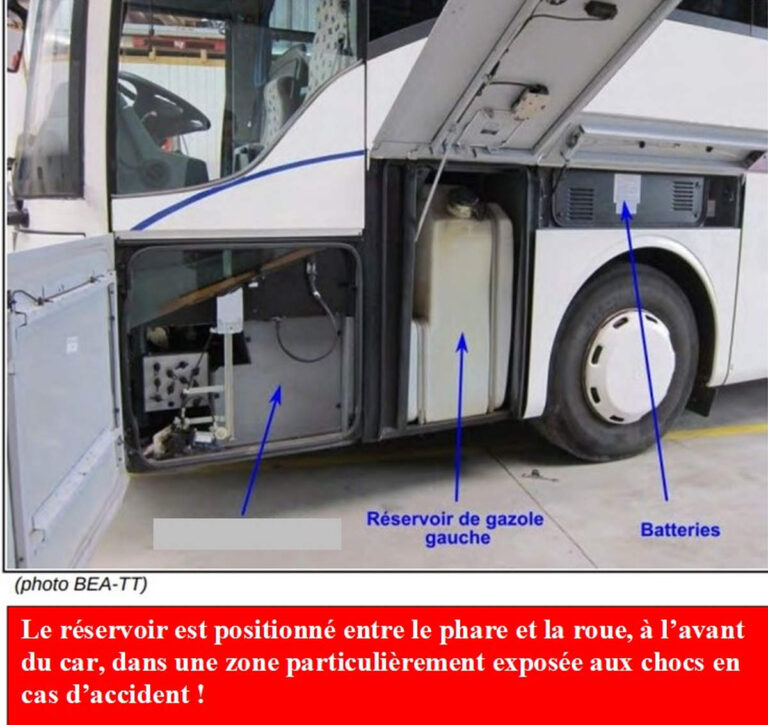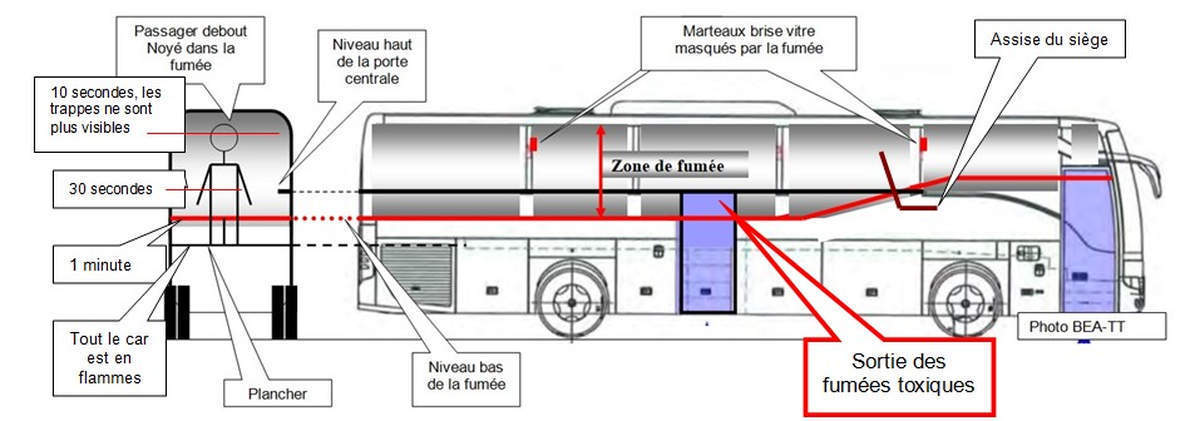Contrary to the official version, a pensioner from Lorraine has identified the probable cause of several fatal coach fires, such as in Beaune (53 deaths in 1982) Puisseguin (43 deaths in 2015), but also in Germany, Bulgaria, Egypt and Algeria… Over 200 deaths, including 100 French. He alerted the authorities. To no avail.

“Like everyone else, I believed the official version of the Puisseguin accident. But when I read the report by the Bureau d’enquêtes sur les accidents de transport terrestre (BEA-TT) in August 2017, I realized that the investigation’s conclusions didn’t hold up.”
In front of his computer in Terville, Moselle, André Léonard scans images of the accident, reads and rereads the various investigation reports, analyzes the gendarmes’ explanations, listens to witnesses to the tragedy, draws sketches… For the past five years, this former truck mechanic, now retired, who describes himself as a whistleblower, has been trying to understand why the Puisseguin coach burst into flames at the moment of impact.
Background
The accident occurred on October 23, 2015 on a small road in Gironde (33), not far from the commune of Puisseguin. An unladen semi-trailer truck suddenly swerved to the left as it rounded a bend, colliding with an oncoming coach carrying 47 members of a senior citizens’ club. Both vehicles burst into flames. The truck driver was killed instantly, and his child died in the furnace, strapped to his seat. In the coach, the driver managed to extricate himself and save several passengers. But 41 people didn’t have time to get out of the vehicle. They died of asphyxiation and burns. It was the deadliest bus accident in France since Beaune in 1982.
Violence and speed of the fire
If the circumstances of the accident are fairly commonplace, how can we explain the violence and speed of the fire? This is the question to be answered by investigators from the Institut de recherche criminelle de la gendarmerie nationale (IRCGN) as part of the judicial inquiry, and by the BEA-TT commissioned by the Ministry of Transport.
The day after the tragedy, Colonel Touron, head of the IRCGN, explained at a press conference that a metal rod used to tighten the truck’s wheels, placed behind the driver, had pierced an additional – non-approved – fuel tank located behind the cab. Under the force of the impact, the diesel spurted out, burst into flames and was projected onto the coach, which in turn caught fire.
This version was later confirmed by the BEA-TT. A documentary film produced by the IRCGN takes up these elements and replaces the metal rod with a much larger “piece of the dismantling cross”. Surprising.
The Puisseguin accident fire-tested (see after 45ᵉ minute).
The truck’s additional fuel tank is not to blame

“These explanations don’t stand up to scrutiny,” says André Léonard. In fact, the fire broke out a few moments after the impact, at a time when flaming fuel could no longer have been projected, as it would most certainly have hit the uninjured driver, inevitably turning him into a living torch. The same applied to the front seat passenger. What’s more, most of the windscreen remained in place (page 81 BEA-TT), preventing any fuel splashes from entering the coach! Finally, the fire started outside the coach and not in the passenger compartment, as the coach driver stated in an interview with BFMTV.
In short, according to André Léonard, “the additional tank was empty, so it can’t be blamed for starting the fire and didn’t fuel it”. As for the metal rod, “it passed within 10 cm of the additional tank.”
Fuel and matches
So what happened? According to André Léonard, it was another tank that was at fault: that of the coach. Coaches are equipped with two 160-liter fuel tanks, positioned at the front of the vehicle, between the bumper and the wheel. They are highly exposed in the event of an accident. This location is all the more dangerous as the electrical box is located in front of the tank. As our Terville-based whistle-blower puts it: “Buses carry both fuel and matches”.
Several factual elements seem to prove him right. One of these is the testimony of the coach driver, who states (page 24 of the BEA report): “A few moments after the impact, a fire broke out between the truck and the coach, at the level of the windscreen”. The report also mentions an “explosion causing a fireball”.
As André Léonard explains, “during the accident, the front left wheel of the truck smashed through the electrical box and the coach’s fuel tank, spraying fuel all over the surrounding area and, above all, onto hot parts of the tractor, notably the brake disc! On contact with these hot parts, the fuel was transformed into vapours, which were ignited by the sparks and arcs emanating from the smashed housing.

Asphyxiation before the fire
After that, everything happened very quickly. The flames melted the plastics. Black, toxic fumes invaded the upper part of the coach’s interior. Lighter than air, they rendered the opening handles of the roof hatches invisible. But opening the doors, releasing the cold, heavy, breathable air close to the ground, marked the start of a deadly countdown. It was quickly replaced by toxic fumes descending to seat level. “On the second breath, you lose consciousness and die. That’s why 41 people lost consciousness in a matter of seconds and died of intoxication on the bus before perishing in the fire.”
The same causes produce the same effects,” observes André Léonard. This is exactly what happened in 1982 in Beaune, on the vacation freeway, where 53 people died, including 46 children. In Bavaria, in 2017, 18 deaths. In Bulgaria, in 2021, 44 dead. In Egypt in 2021, 10 dead, including 4 French. In Algeria, in 2023, 34 dead (the fact that the bus was hit by a vehicle carrying petrol does not change the origin of the fire). Without the cans, the destruction of the fuel tank and electrical box would still have resulted in a fire.

“We need to change the legislation”
André Léonard’s explanations are all the more pertinent given that 70,000 coaches on France’s roads today, and 50% of city buses, are equipped with tanks located at the front of the wheels, near the electrical box. Walking bombs. He is therefore calling for a change in legislation to prohibit these tanks from being placed in front of the wheels, and for roof hatches to open automatically in the event of fire…
Since these points are not on the agenda, tomorrow’s buses are just as dangerous as the one in Puisseguin! That’s why he’s fighting to have the cause of the Puisseguin fire recognized. He has alerted the Libourne public prosecutor, the examining magistrate in charge of the case, the Minister of Transport, Brussels… Alerts that have gone unanswered.
Until the next tragedy?

Location of the fuel tank in the charred Puisseguin coach (Photo Gendarmerie)
